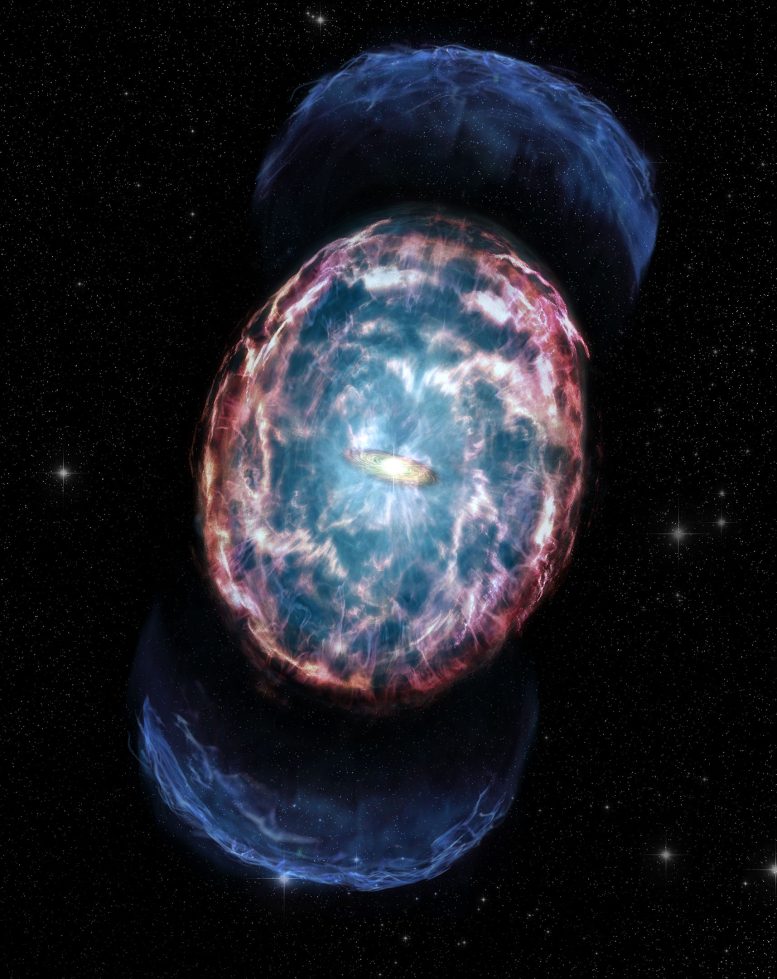
El concepto del artista representa la recaída de Kilonova, un poderoso evento que ocurre cuando dos estrellas de neutrones se fusionan. Préstamo de rayos X: NASA / CXC / Northwestern Univ./A. Hajela և otros; Ilustración de NASA / CXC / M.Weiss
El extraño «boom sonoro» estuvo acompañado de un hecho sin precedentes.
- Misteriosos rayos X se observaron 3,5 años después de la fusión de dos estrellas de neutrones
- Los astrofísicos creen que kilos de materia o materia caen un[{» attribute=»»>black hole might have caused the X-ray emission
- Either scenario would be the first for the field
- The kilonova afterglow was likely produced by a shock similar to a sonic boom, generated by expanding debris from the merger
For the first time, Northwestern University-led astronomers may have detected an afterglow from a kilonova.
A kilonova occurs when two neutron stars — some of the densest objects in the universe — merge to create a blast 1,000 times brighter than a classical nova. In this case, a narrow, off-axis jet of high-energy particles accompanied the merger event, dubbed GW170817. Three-and-a-half years after the merger, the jet faded away, revealing a new source of mysterious X-rays.
As the leading explanation for the new X-ray source, astrophysicists believe expanding debris from the merger generated a shock — similar to the sonic boom from a supersonic plane. This shock then heated surrounding materials, which generated X-ray emissions, known as a kilonova afterglow. An alternative explanation is materials falling toward a black hole — formed as a result of the neutron star merger — caused the X-rays.
Ambos escenarios serán los primeros para el campo. El estudio fue publicado el 28 de febrero de 2022 en Ereván. Las cartas del diario astrofísico:.
«Entramos en un área no descubierta aquí para estudiar los efectos de la fusión de estrellas de neutrones», dijo Aprajita Hajela, directora de New Research. «Esta es la primera vez que vemos algo nuevo e inusual. Esto nos permite estudiar y comprender nuevos procesos físicos que no se habían observado antes”.
Hajela es estudiante de posgrado en el Centro de Astrofísica del Noroeste և Centro de Investigación C Centro de Investigación (CIERA) և Facultad de Artes de Weinberg ֆ և Física և Cátedra de Astronomía.
El 17 de agosto de 2017, GW170817 pasó a la historia como la primera fusión de estrellas de neutrones descubierta por los dos.[{» attribute=»»>gravitational waves and electromagnetic radiation (or light). Since then, astronomers have been using telescopes around the world and in space to study the event across the electromagnetic spectrum.
We are looking at something new and extraordinary for the very first time.”
— Aprajita Hajela, astrophysicist
Using NASA’s Chandra X-ray Observatory, astronomers observed X-ray emissions from a jet moving very close to the speed of light produced by the neutron star merger. Starting in early 2018, the jet’s X-ray emission steadily faded as the jet continued to slow and expand. Hajela and her team then noticed from March 2020 until the end of 2020, the decline in brightness stopped, and the X-ray emission was approximately constant in brightness.
This was a significant clue.
“The fact that the X-rays stopped fading quickly was our best evidence yet that something in addition to a jet is being detected in X-rays in this source,” said Raffaella Margutti, astrophysicist at the University of California at Berkeley and a senior author of the study. “A completely different source of X-rays appears to be needed to explain what we’re seeing.”
The researchers believe a kilonova afterglow or black hole are likely behind the X-rays. Neither scenario has ever before been observed.
“This would either be the first time we’ve seen a kilonova afterglow or the first time we’ve seen material falling onto a black hole after a neutron star merger,” said study co-author Joe Bright, also from the University of California at Berkeley. “Either outcome would be extremely exciting.”
To distinguish between the two explanations, astronomers will keep monitoring GW170817 in X-rays and radio waves. If it is a kilonova afterglow, the X-ray and radio emissions are expected to get brighter over the next few months or years. If the explanation involves matter falling onto a newly formed black hole, then the X-ray output should stay steady or decline rapidly, and no radio emission will be detected over time.
“Further study of GW170817 could have far-reaching implications,” said study co-author Kate Alexander, a CIERA postdoctoral fellow at Northwestern. “The detection of a kilonova afterglow would imply that the merger did not immediately produce a black hole. Alternatively, this object may offer astronomers a chance to study how matter falls onto a black hole a few years after its birth.”
The study, “Evidence for X-ray emission in excess to the jet afterglow decay 3.5 years after the binary neutron star merger GW170817: A new emission component,” was supported by NASA, the National Science Foundation, the U.S. Department of Energy and the Royal Astronomical Society.
También te puede interesar
-
El telescopio espacial Webb de la NASA detecta vapor de agua en la zona de formación de planetas rocosos
-
Una línea escondida en las profundidades del océano divide a los animales en dos campos. Alerta científica:
-
El Telescopio Espacial James Webb detecta agua cerca del centro del disco en formación del planeta
-
La misión de impacto de asteroides de la NASA desencadena una avalancha sorpresa de rocas espaciales. Alerta científica:
-
La armadura secreta de los ratones espinosos africanos